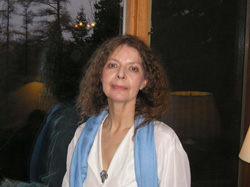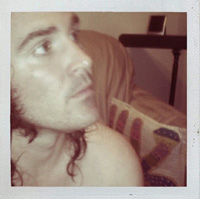To Be Moved by a Poem:
stephen e. leckie in Conversation
with Anne Compton

Malahat volunteer stephen e. leckie talks with poet Anne Compton about her contribution of three poems to Issue 187, our upcoming Summer 2014 issue. Compton is the winner of numerous literary awards, including the Atlantic Poetry Prize, the Governor General's Award for Poetry, and a National Magazine Award in Poetry.
Read on to learn about Compton's take on language, process, and inspiration.
Anne, thank you for taking the time to talk about your poems. This current work: “Tablecloth and Other Compound Words,” “Sleeping in the spare,” and “The River in Spring” (forthcoming in Issue 187, Summer 2014 of the Malahat), resound with an interpersonal emotionality that left me feeling the images as “a received geometry.” Is your process divergent from how you wrote in Opening the Island (2002), Processional (2005), Asking questions indoors and out (2009) and Alongside (2013), or does home, family, and nature still offer surprises with all the forms available to you?
My process hasn’t changed much. Each book is an occasion to explore an idea that is preoccupying me. Alongside is about beauty; Asking questions indoors and out is about faith and doubt; Processional is concerned with the procession of the seasons. After writing 8 or 10 poems, I examine them closely, see what the preoccupying idea is and go with that for the whole manuscript. Observations and memories tend to collect around that central idea for a period of three or four years, yielding the poems that make up the book. As for individual poems, each one begins with something observed or something overheard—the visual or the auditory witnessed. Or, the poem begins with a memory—an image that seems to come out of nowhere. I can go months without writing a poem, but there isn’t a day where I don’t write something down in my copybook. And, yes, nature, home, family continue to interest me, but then, so do time and mortality, both of which are implicit in the trio of things you name.
To borrow a question from Tim Bowling: have reviews and awards affected your process, affirmed that your senses are sharp and discerning?
Receiving an award is affirming, a confirmation that someone’s reading your work, but an award in no way changes one’s deeply intuitive writing habits. Oddly enough, though, reviews can alert you to practices in your work that you weren’t aware of. A UK reviewer said “[Compton’s] style is to use quite short sentences combined into long lines. Her technique is to push quite dense material into the short sentences and then pull that through the long lines so that you hang on to the threads of what she is doing” (Manchester Review). I had no idea that my thinking unfolded in that way.
In “Tablecloth and Other Compound Words” I kept thinking about the reversibility of the “damask” and what language would do with *boardside, *panewindow, or *clothtable. Do you find that language helps or hinders the rendering of emotions and experiences? Are you using kennings as a way into the social setting of the poem?
I’m not sure emotion and experience are expressible without language. Maybe a visual artist can do that. Language enables a writer to establish and clarify what’s been experienced or imagined, and to give communicable shape to emotion. Language is a way of being awake in the world, a way of knowing, and bringing to consciousness, what’s been experienced.
About the compounds, I don’t know that they are about “social setting,” although it’s probably true that usage is local and regional. On the East Coast, we have the compound “hangashore,” which very well may be a localism. But in this poem it is the “recursive” nature of compounds that I’m especially interested in. I remember reading somewhere that when humans got recursive thinking, it was a cognitive leap ahead, the ability to think more associatively. But you’re right; the poem—through the image of the “damask”—is also interested in reversibility. “Spareleaf”—the piece that makes the table larger—is also “leafspare,” a G.M. Hopkins kind of image, trees in their fall and winter state. Either way—leafspare or spareleaf—we’re in the world of wood. Compounds deal in tactility, the concrete things of the world. We can see with one eye, but two eyes enable us to see depth. Similarly, with words we can name objects, but syntax, not to mention figurative speech, enables us to see the connectedness of things. Recursiveness and reversibility testify to our experience of connectivity. Overall, the poem is interested in the parallels between language and dining. A table setting is a received language, a grammar and a code.
“Sleeping in the spare” seems to offer spiritual guidance. I am not familiar with some of the religious elements in the poem. Could you speak to your use of light and the effects of the couplets?
Although “Sleeping in the spare” quotes a passage from the Bible, it’s more ghost poem than religious poem. Sometime after writing that poem, I read Michael Cunningham’s novel Specimen Days, where a character asks, “Do ye think sleeping is safe?” I’d answer that with a resounding “No.” Given the instability of the self, “dusk”, and dusk-into-darkness, is a dangerous time. The supposedly stable self is at risk. It can be carried off, transformed, transferred into other identities. In this poem, weirdness doesn’t stop with the “flitch of dawn,” with waking. In his brilliant book The Other Night, Herschel Forman says, “What wakes when the ‘I’ sleeps doesn’t sleep when the ‘I’ wakes.” The ghazal-like structure of the poem allows for loosely associative imagery, much like the way we experience images in dreams.
There is a kind of magic happening in “The River in Spring”, especially the relationship between the “glaciated riverbed” and the “sunlight”. Is this river a place you visit often? Does the liminal space of “shore” and “water” serve to negotiate something symphonic about nature?
My house overlooks a broad, deep river, and, yes, I’m often down to the shore. Every spring I record the date of the ice break-up. The day the ice goes out is itself magical. The sound of grinding ice is replaced by the rhythm of waves. The water, initially brown with debris, surges wildly. “The River in Spring” simply takes that magic further, supposes that the ice sheet sinks, in one piece, to the riverbed. The strong spring sun seeks it there, illuminating it extravagantly. Given the strangeness of that light, people who live near the shore don’t know if they wake or sleep.
Who are you reading right now? What do you look for in a poem?
I am currently reading a graceful new work by Ross Leckie, The Critique of Pure Reason and a wonderful nature calendar, Ringing Here & There, by Brian Bartlett. I am always dipping into the work of Michael Symmons Roberts, John Glenday, Don Domanski, and Sue Sinclair. Their books are always on the floor by my reading chair, as is Wes Davis’ An Anthology of Modern Irish Poetry.
In a poem I want sinuous syntax, metaphors that surprise—linguistic playfulness—and semantic depth. But above all, I want to be moved by a poem.

stephen leckie
* * * * * * * *









